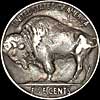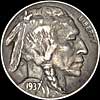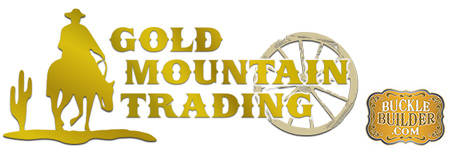 $100 min purchase Continental U.S. only
$100 min purchase Continental U.S. only The Indian Buffalo Nickel by James Earle Fraser 1876 - 1953

 American sculptor James Earle Fraser began designing the Indian Buffalo nickel in 1911. Fraser said the portrait on the "head's" side was a composite of three American Indians - Iron Tail, Big Tree and Two Moons. James Earle Fraser had the opportunity to study and photograph them when they stopped in New York on their way to Washington to visit President Theodore Roosevelt. By borrowing features from each individual, Fraser was able to sketch the "ideal" portrait for the nickel.
American sculptor James Earle Fraser began designing the Indian Buffalo nickel in 1911. Fraser said the portrait on the "head's" side was a composite of three American Indians - Iron Tail, Big Tree and Two Moons. James Earle Fraser had the opportunity to study and photograph them when they stopped in New York on their way to Washington to visit President Theodore Roosevelt. By borrowing features from each individual, Fraser was able to sketch the "ideal" portrait for the nickel.
The model for the "tail's" side of the coin was a buffalo named Black Diamond, a resident of New York's Bronx Zoo. He was born of stock donated by the Barnum and Bailey circus. In his prime, Black Diamond's coat was unusually dark, and he weighed more than 1500 pounds.
James Earle Fraser stood for hours, trying to catch his form and mood in clay. But Black Diamond stubbornly refused to show his side view, and faced the artist most of the time. Only by bribing a zoo attendant to distract the animal was Fraser finally able to capture the likeness he wanted.
President William Howard Taft approved the artwork, and the first Buffalo nickels were produced in February of 1913. When the Buffalo nickel finally made its debut, many hailed it as a true work of art. Many critics agreed, and in 1951 the American Academy of Arts and Letters presented Fraser with a gold medal honoring a lifetime of distinguished achievement. (Fraser also crafted the famous End of the Trail sculpture. James Earle Fraser died on October 11, 1953.
Two Moons died in 1917, and Iron Tail and Big Tree in the 1920s. In the 1960s, a second Big Tree appeared at coin shows and claimed to be the Native American on the nickel. Although he claimed to have celebrated his 100th birthday in 1962, later records indicated he was actually only 87.
A single coining press at the Philadelphia Mint started turning out the nickels at the rate of 120 a minute. Treasury Secretary Frank MacVeagh promised the nickel would be "immensely interesting and beautiful." But after the first examples were placed in circulation, the New York Times condemned them as a "travesty on artistic effect."
Other critics said that the coin's "rough" surfaces would encourage counterfeiters (imagine someone wanting to counterfeit a nickel these days!) But the most serious complaint about the nickel had to do with its inability to withstand heavy use. One coin collectors' magazine predicted that the slightest wear would obliterate the date and the inscription Five Cents "beyond understanding."
Soon after production of Buffalo nickels began, the design was modified. The early coins showed the bison standing on a grassy mound. For the new version, engraver Charles Barber cut away the base of the mound to make a straight line. He also lowered the words Five Cents so the rim would protect them from wear.
Collectors noticed right away that the inscription was clearer. But the changes did not help the date on the other side of the coin. Erosion of the numerals continued to plague Buffalo nickels. Government officials scrapped the design altogether in 1938, after it reached the minimum statutory life of 25 years. Millions of these nickels once thrived across the country, but in 1938 the Buffalo nickel became an endangered species.
From the beginning, there had been complaints about using a Native American and a bison on the coin. One collectors' magazine questioned whether either was a good symbol of liberty, considering that many Indians had been forced onto reservations, and the American bison had been slaughtered to the brink of extinction.
In 1938, the Treasury Department staged a competition for a new nickel picturing Thomas Jefferson. According to a news item of the day, the Bureau of Indian Affairs didn't receive a single complaint from Native Americans about the design change. Collectors didn't seem to mind either. But production of Buffalo nickels continued until the first Jefferson nickels were struck in September. By then the Denver Mint had turned out more than 7 million buffalo nickels that were dated 1938. They were the last of the breed. ![]()
Information courtesy of American Numismatic Association.
